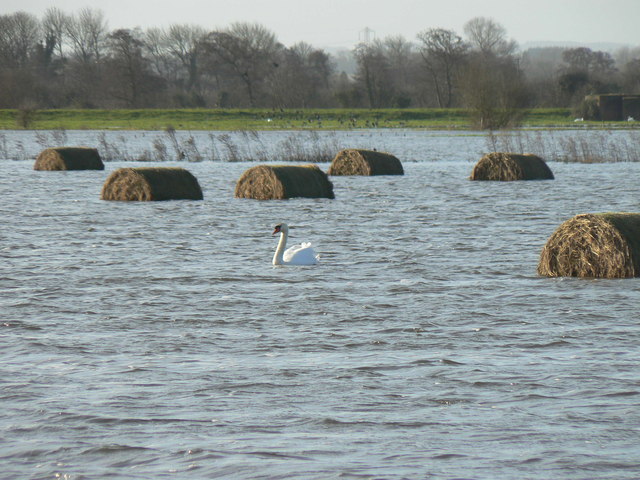
under the Creative Commons Attribution-Share Alike 2.0 Generic Licence.)
Those of us who remember then Prime Minister David Cameron’s speech following the severe floods in the Somerset Levels in February 2014 (“…money is no object in this relief effort. Whatever money is needed for it will be spent”) might be forgiven for thinking that we must therefore have a right to be defended from flooding.
With the predicted rise in sea levels in the coming years and the increased instances of extreme weather that we are already experiencing, how to protect ourselves from flooding is becoming an increasingly important topic. However, the reality is that where a property is protected from flooding by flood defences on another party’s land, there are only minimal opportunities for the owner of that property to require that the flood defences are kept in good maintenance and repair. The action taken by the government in 2014 appears to have been motivated purely by political considerations and not by any legal rights of those living and working in the Somerset Levels.
Where the flood defences protecting a property are public defences, the first recourse must be to statute law. The statute law on flooding is extensive,[i] but the only duties on public authorities in relation to flooding are in respect of flood risk planning and flood warning systems. Everything else is expressed as a power and not a duty. This distinction is important as case law makes it clear that a power is something that a statutory authority has a discretion as to whether to use or not.[ii] Which all means that anyone suffering from the absence of public flood defences or from poorly maintained public flood defences is unlikely to be able to persuade a court to compel the relevant body to construct or maintain those defences.
Where the relevant flood defences are privately owned by an adjoining landowner, it may be possible to enforce the maintenance and repair of those flood defences through the torts of private nuisance or negligence. A claim in nuisance is preferable as the remedies it allows are not limited to damages only (as in negligence); an injunction is possible, which would require the adjoining landowner to repair and maintain the flood defences without having to wait for a flood to cause damage first.
In either action, the starting point is that landowners are subject to a duty to their neighbours to do what is reasonable in the circumstances to prevent or minimise the risk of harm to that neighbour from the landowner’s property[iii] (in this case from the escape of flood water from the landowner’s property). However, the hopeful claimant should note that case law has shown that what is reasonable will not necessarily extend to actually carrying out the acts of repair and maintenance required (mere information sharing about the possible risk may be sufficient).[iv] In addition, even if it is considered reasonable to carry out such acts of repair and maintenance, the costs will not necessarily fall entirely to the owner of the flood defences.[v] It is possible that the party seeking their repair and maintenance could be required to pay towards those costs, which may be significant.
An alternative possibility is the law of prescription (in which a right over a property is acquired through long use, provided there has been no force, secrecy or permission). It is possible to acquire a right to demand that the owner of flood defences that benefit your property keep those defences in good maintenance and repair.[vi] However, the requirements that must be satisfied before such a claim can be established are such that it would be incredibly difficult to succeed on this basis. A claimant would have to show that the flood defence owner has carried out repairs over a sufficient period of time (usually 20 years) and provide proof that these repairs were not carried out voluntarily but through some perceived obligation to the claimant.
In short, there is very little in the way of prospects for those seeking to claim the benefit of flood defences not situated on their property. A hope that the government will step in may be all that is available. Nonetheless, the prospect of flooding damage is one that increasing numbers of us may have to face in the coming years. The current law is unable to help in most flooding situations and so we can only hope that novel solutions can be found to what is becoming a competition between nature and human society.
Acknowledgment: This post is on an article in the Journal of Water Law by Emma Bean, Prof Chad Staddon and Dr Thomas Appleby.
*
[i] Contained in the Land Drainage Act 1991, Water Resources Act 1991, Water Industry Act 1991, Environment Act 1995, Coast Protection Act 1949 and Flood and Water Management Act 2010
[ii] Bybrook Barn Garden Centre Limited v Kent County Council [2001] Env LR 543 (AC)
[iii] Leakey and others v National Trust for Places of Historic Interest or Natural Beauty [1980] QB 485 (AC)
[iv] Holbeck Hall Hotel v Scarborough Borough Council [2000] QB 836 (AC)
[v] Abbahall v Smee [2002] EWCA Civ 1831; [2003] 1 WLR 1472 (AC)
[vi] Jones v Price [1965] 2 QB 618 (AC), Egerton v Harding [1975] QB 62 (AC)
